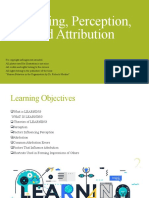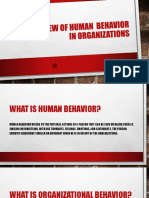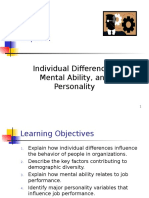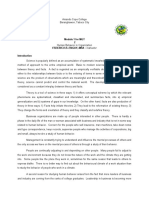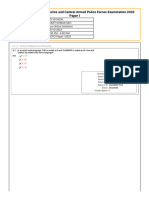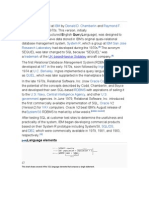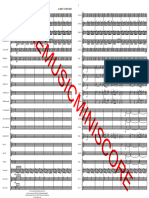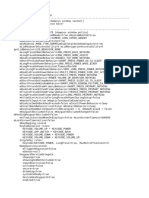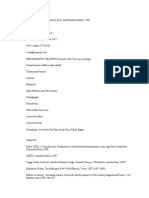HBO Handouts
HBO Handouts
Uploaded by
Janelle DizonCopyright:
Available Formats
HBO Handouts
HBO Handouts
Uploaded by
Janelle DizonOriginal Title
Copyright
Available Formats
Share this document
Did you find this document useful?
Is this content inappropriate?
Copyright:
Available Formats
HBO Handouts
HBO Handouts
Uploaded by
Janelle DizonCopyright:
Available Formats
Course Subject : HUMAN BEHAVIOR IN ORGANIZATION
Term : 2ND Semester 2018-2019
Instructor : Mark Anthony R. Casem, MBA, DBA
Schedule : WedFri 4:30 – 6:00 PM
E-mail address : casemmarkanthony@yahoo.com
TOPIC : FUNDAMENTALS OF HUMAN BEHAVIOR
“ Many of our most critical problems are not in the world of things, but in the world of
PEOPLE”. The study of human behavior, therefore, is just as important, if not more
important, than study of things. Indeed, there is no other subject more interesting and
challenging than people.”
Situation # 1
A story is told of an executive who had to drive some distance to his head office for
conference with his President
On his way, his car tires went off in a place near a mental hospital. He had
difficulty putting them back to be in time for his appointment when along came a man,
apparently a patient who was trying to escape from the institution.
The latter offered to help and to presto! The tires were in place in such a short time
much to amusement and pleasure of the business executive who uttered
“ Hey, man you’re a wizard. But why are you in this mental hospital?”
The man replied with twinkle in his eyes, “ I may be crazy but I am not stupid as you
are!”
What personal characteristics does each of the two actors in the story possess which
have affected their behavior? Can we compare the behavior of the executive and that of
the mental patient?
Situation # 2
It was observed with concern by a small group of employees of a marketing firm that
Rita was not eating her lunch for the fourth day with them. Her individual behavior
amazed them since she usually led the group to come together, start the meal and
recount the “stories” of the day.
What made Rita change her behavior? How did this affect the group? How would she
react if the group asked her the reason for her acting differently?
NATURE AND SCOPE OF HUMAN BEHAVIOR
Any act of an individual person which is considered human behavior is a reflection of his
thoughts, feelings, emotions, sentiments whether conscious or not.
It mirrors his needs, values, motivation, aspirations, conflicts and state of life.
Behavior, therefore, consists of all human activities.
The principles and concepts that underlie behavior are basic. It is their implementation
and practice that differ from group to group or from country to another. This culture-
laden behavior is best illustrated in the following incident.
One afternoon in a memorial park, a group of Chinese placed food on top of the tomb of
their dead while the Americans laid flowers to venerate their dead.
The Americans who were wondering why the Chinese used food sent a representative
to the Chinese group to inquire, “ When are your dead coming up to eat your food?”.
A quick Chinese retorted, “ At the very same time your dead will come up to smell your
flowers!”
Reverence for the dead is universal. It is how each culture manifests it that spells the
difference.
NATURE OF SCIENCE
Science is popularly defined as an accumulation of systematic knowledge based
on facts.
It is a method of approach to the entire empirical world.
Basic to modern science is an intricate relation between theory and facts.
FACT is regarded as an empirically verifiable observation
THEORY refers either to the relationships between facts or to
the ordering of terms in some meaningful way.
WHY THE STUDY OF HUMAN BEHAVIOR
Business organizations are made up of people interested in other people.
1. People are continually adjusting to and depending on other people. Many people
fail to adjust to the work environment because they do not know the nature of the
work and the climate they are getting into.
2. A second reason for studying human behavior arises from the fact that more and
more leaders of business and industry are coming from the ranks of college
graduates.
3. A knowledge of the principles of the human behavior will help one acquire
understanding, skills, and desires which will prepare him to work with others with
increasing cooperation, understanding and effectiveness.
DEVELOPMENT OF THE SCIENTIFIC STUDY OF HUMAN BEHAVIOR
The scientific study of human behavior was only a 19 th century development. Until the
later of the 19th century, philosophy was only approach to the study of human behavior.
The direct forerunner of psychology is PSYCHOPHYSICS – a science developed by
Fechner.
It is a science that studied the functional relations of dependency between mind
and body but which actually determined the physical characteristics of stimuli and the
sensations they produce.
UNDERSTANDING HUMAN BEHAVIOR
The majority of theories and models of human behavior fall into one of two basic
categories :
INTERNAL PERSPECTIVE considers the factors inside the person to understand
behavior. People who subscribe to this view understand human behavior.
This view is psycho dynamically oriented.
Behavior is explained in terms of the thoughts, feelings, past experiences and needs of
the individual.
The internal processes of thinking, feeling, perceiving and judging lead people to act in
specific way.
This internal perspective implies that people are best understood from the inside and
that people’s behavior is best interpreted after understanding their thoughts and
feelings.
The other category of theories takes an EXTERNAL PERSPECTIVE. This focuses on
factors outside the person to understand behavior.
External events, consequences of behavior, environmental forces to which a person is
subject, are emphasized by this external perspective.
A person’s history, value system, feelings and thoughts are not very important in
interpreting actions and behavior.
Kurt Lewin considered both perspectives in saying that behavior is a function of both the
person and the environment.
DEVELOPMENT OF BEHAVIORAL SCIENCE
The term “behavioral science” came into use only in the 1950’s when the Ford
Foundation coined it to describe its program on Individual Behavior and Human
Relations.
Behavioral Science has emerged as a new integrated discipline that is primarily
concerned with valid generalizations about human behavior in group situations from
viewpoints of psychology, sociology, and cultural anthropology.
To qualify as a behavioral science, a field of study must satisfy TWO BASIC CRITERIA
First, it must have human behavior as its subject matter; Second, it must study
human behavior in a scientific manner.
The second criterion must be very clearly understood because the study of human
behavior is by no means the exclusive monopoly of the behavioral sciences.
BASIC DEFINITIONS
The two words from which the term “ behavioral science” is derived are BEHAVIOR and
SCIENCE.
Science may be defined from two viewpoints :
STATIC VIEW defines science as a body of knowledge. Its emphasis is on the
scientific activity ( research) rather than on the activity itself.
DYNAMIC VIEW defines science as an activity as such, it is more concerned
with what scientists do.
Human Behavior may be defined as any activity of an individual or group, whether
such activity can be observed by another person or detected by scientific instruments.
Specific definitions : It is the response of an individual to stimulus situation. It refers to
both the types of responses and the manner in which it was made.
It refers not only to what the person does but also how he does it.
A stimulus situation refers to a factor, condition, situation or a combination of factors
( whether internal or external) which provide the occasion for a response.
ORGANIZATIONAL BEHAVIOR is individual behavior and group dynamics in
organization. The study of organizational behavior is concerned with the psychosocial,
interpersonal, and behavior dynamics in organizations.
However, organizational variables such as design of work, performance appraisal,
communication, organization structure, etc., are also relevant to the study of
organizational behavior.
BEHAVIORAL SCIENCES recognize human behavior as having three characteristics :
First, that is it is CAUSED; second, it is MOTIVATED or GOAL-ORIENTED; and third, it
is INTEGRATED – that the individual’s motives, emotions, cognitions and self-
concepts, his attitudes, value systems, etc.
BASIC STEPS IN RESEARCH
Statement of the Problem
research begins with defining and searching the problem, expressing it in explicit
and concrete terms.
The Research Design
This generally involves the following steps :
1. determining the type of data needed;
2. identifying the source of data;
3. selecting the methods generally used in the study of human behavior are:
Analytic or Documentary, experimental, survey and case;
4. Choosing the subject or formulating the sampling plan.
Processing the Data
Coding is a technical process by which raw data are transformed into symbolic or
numbers that may be tabulated.
Tabulation is a systematic method of counting similar replies and adding them in an
accurate and orderly manner.
Analysis and Interpretation
There are two basic methods of analyzing data :
1. Statistical; and
2. Inferential
Correlation determines what is average or typical and finds out the extent of diverse
behavior and others
Inferential analysis is the process of determining the meaning of evidence by reflective
thinking.
You might also like
- A Book Report in Human Behavior in OrganizationDocument3 pagesA Book Report in Human Behavior in OrganizationJanice50% (4)
- Human Behavior in OrganizationDocument143 pagesHuman Behavior in Organizationkuko11198% (95)
- Human Behavior Organization Final ExamDocument3 pagesHuman Behavior Organization Final ExamJinky Bago AcapuyanNo ratings yet
- Human Behavior in OrganizationsDocument5 pagesHuman Behavior in OrganizationsJennybabe Peta100% (1)
- Organization Behaviour Lecture Notes (1) - 1Document41 pagesOrganization Behaviour Lecture Notes (1) - 1dickson sengeraNo ratings yet
- Human Behavior in OrganizationDocument3 pagesHuman Behavior in OrganizationJoram David BeltranNo ratings yet
- HBO Chapter 2Document11 pagesHBO Chapter 2Bea-ayesha A. Pandao100% (1)
- Human Behavior in OrganizationDocument46 pagesHuman Behavior in OrganizationJeanelle Argonza100% (11)
- The Stages of The Employment Cycle: Study Guide For Module No. - 3Document3 pagesThe Stages of The Employment Cycle: Study Guide For Module No. - 3Jasmine AlvianaNo ratings yet
- Human Behavior in Organization Chapter 1.Document22 pagesHuman Behavior in Organization Chapter 1.Franchezka Pegollo86% (7)
- Chapter I - Fundamentalof Human BehaviorDocument26 pagesChapter I - Fundamentalof Human BehaviorDohly Bucarile100% (9)
- Walt Disney Records The Legacy Collection: DisneylandDocument24 pagesWalt Disney Records The Legacy Collection: DisneylandНадежда Рыжкина100% (4)
- Human Behavior in Business Organization IMDocument29 pagesHuman Behavior in Business Organization IMkimberly ebilane100% (2)
- Human Behavior in Organization Chapter 1 SummaryDocument1 pageHuman Behavior in Organization Chapter 1 SummaryYI Lie Suddenly ZhangNo ratings yet
- Human Behavior in OrganizationDocument8 pagesHuman Behavior in OrganizationJanRalphBulanonNo ratings yet
- Overview of Human Behavior in OrganizationDocument29 pagesOverview of Human Behavior in OrganizationMarjon DimafilisNo ratings yet
- CHAPTER 1 An Overview in Human Behavior in OrganizationsDocument11 pagesCHAPTER 1 An Overview in Human Behavior in OrganizationsJINNY CLAIRE VILLAROJO100% (1)
- Human Behavior in OrganizationDocument143 pagesHuman Behavior in Organizationlloyd mataNo ratings yet
- Lecture 3 Learning, Perception and AttributionDocument45 pagesLecture 3 Learning, Perception and AttributionNica Brazil100% (2)
- Hbo Module 1Document11 pagesHbo Module 1Joresol Alorro100% (1)
- Human Behavior in OrganizationDocument12 pagesHuman Behavior in OrganizationMahonri R. AraojoNo ratings yet
- Human Behavior in Organization Course Learning OutcomesDocument21 pagesHuman Behavior in Organization Course Learning OutcomesJasmine Quiobe100% (1)
- Chapter 1 - An Introduction To Human Behavior in OrganizationDocument8 pagesChapter 1 - An Introduction To Human Behavior in OrganizationSteffany RoqueNo ratings yet
- Human Behavior in OrganizationDocument28 pagesHuman Behavior in Organizationlloyd mata100% (6)
- An Overview of Human Behavior in OrganizationsDocument15 pagesAn Overview of Human Behavior in OrganizationsRudel SolarNo ratings yet
- Nature of People: PA 251: Human Behavior in The OrganizationDocument48 pagesNature of People: PA 251: Human Behavior in The OrganizationBaisheigrid Pia AkmadNo ratings yet
- Human Behavior in OrganizationDocument11 pagesHuman Behavior in OrganizationRasalyn Cericos ValoisNo ratings yet
- Why To Study Human Behavior in The OrganizationDocument2 pagesWhy To Study Human Behavior in The OrganizationKoré Perséfone D'Paganus90% (10)
- Human Behavior in Organization Reviewer...Document6 pagesHuman Behavior in Organization Reviewer...Jessah Mae BirolNo ratings yet
- CHAPTER 2-Individual Differences Mental Ability and PersonalityDocument16 pagesCHAPTER 2-Individual Differences Mental Ability and PersonalityDenise Cruz100% (13)
- MC 101Document720 pagesMC 101Anamika Rai PandeyNo ratings yet
- Human Behavior in An OrganizationDocument34 pagesHuman Behavior in An Organizationsteve dela rosa100% (1)
- Hbo PrelimDocument50 pagesHbo PrelimJoseph Consignado100% (1)
- Human Behavior in OrganizationDocument143 pagesHuman Behavior in OrganizationBeverly DoctoleroNo ratings yet
- Module 1 - Definition and Scope of Human Resource ManagementDocument11 pagesModule 1 - Definition and Scope of Human Resource ManagementAutumn SapphireNo ratings yet
- HBO..Lesson 1 - An OverviewDocument9 pagesHBO..Lesson 1 - An OverviewJoe P PokaranNo ratings yet
- Human Behaviour in Organisation - ITM University - Semester 2 - MBADocument162 pagesHuman Behaviour in Organisation - ITM University - Semester 2 - MBAUnknown100% (1)
- The Impact of Financial Literacy On Investment BehaviourDocument5 pagesThe Impact of Financial Literacy On Investment BehaviourFadhil Chiwanga100% (1)
- Human Behavior in Org. ResearchDocument10 pagesHuman Behavior in Org. ResearchDarlene MagpantayNo ratings yet
- Fundamentals of Human Behavior 1Document4 pagesFundamentals of Human Behavior 1Coke Aidenry SaludoNo ratings yet
- Human Behavior in OrganizationDocument3 pagesHuman Behavior in OrganizationCristine S. Dayao100% (2)
- PRELIM EXAM in HUMAN BEHAVIOR IN ORGANIZATIONDocument6 pagesPRELIM EXAM in HUMAN BEHAVIOR IN ORGANIZATIONCristel Anne A. LlamadorNo ratings yet
- Human Behavior in Organization Chapter2 SummaryDocument3 pagesHuman Behavior in Organization Chapter2 SummaryYI Lie Suddenly ZhangNo ratings yet
- Human Behavior in OrganizationDocument41 pagesHuman Behavior in OrganizationReymart Tandang Ada100% (1)
- Strategic Chapter 1Document36 pagesStrategic Chapter 1Sunnie LyeNo ratings yet
- Module 2 Human Behavior in OrganizationDocument22 pagesModule 2 Human Behavior in OrganizationReymark Mores100% (1)
- Individual Process in OrganizationDocument102 pagesIndividual Process in OrganizationMahesh Rangaswamy100% (4)
- Hbo Term Paper PDFDocument39 pagesHbo Term Paper PDFMary Ellen LuceñaNo ratings yet
- MGT 2 HBO Activity 1Document26 pagesMGT 2 HBO Activity 1Jomari RealesNo ratings yet
- Scientific Views About The SelfDocument16 pagesScientific Views About The Selfarmyahgase 11No ratings yet
- Module 1 - Introduction To Social PsychologyDocument5 pagesModule 1 - Introduction To Social PsychologyAayush100% (1)
- Human Behavior in Organization Chapter 01: Fundamentals of Human Behavior A. IntroductionDocument5 pagesHuman Behavior in Organization Chapter 01: Fundamentals of Human Behavior A. IntroductionJomar TeofiloNo ratings yet
- Understanding The SelfDocument17 pagesUnderstanding The SelfRyan MirandaNo ratings yet
- Social Psychology PDFDocument115 pagesSocial Psychology PDFDr. Deepti Sharma100% (1)
- Social Cognitive and Trait Theories ReviewerDocument4 pagesSocial Cognitive and Trait Theories ReviewerbacbencioNo ratings yet
- MPC-004 Set4Document12 pagesMPC-004 Set4aaravbharti321No ratings yet
- Human NatureDocument21 pagesHuman Naturedudedid103No ratings yet
- Social PsychologyDocument17 pagesSocial Psychologyimtiaz100% (1)
- MR Femi assignm-WPS OfficeDocument14 pagesMR Femi assignm-WPS Officeoluwasegunsamuel009No ratings yet
- PSY Unit - IDocument23 pagesPSY Unit - IvenkateshamNo ratings yet
- Bba 101Document134 pagesBba 101gollohtradeNo ratings yet
- Spanish MaterialsDocument3 pagesSpanish MaterialsCarlos RodriguezNo ratings yet
- Attacheme NTDocument18 pagesAttacheme NTTerefe Bergene bussaNo ratings yet
- SSC Digialm Com Per g27 Pub 2207 Touchstone AssessmentQPHTMLMode1Document74 pagesSSC Digialm Com Per g27 Pub 2207 Touchstone AssessmentQPHTMLMode1Harsh BhardwajNo ratings yet
- Fauji Fertilizer Bin Qasim Limited: Human Resource Management "HR Practices in DCS Project" With Reference ToDocument26 pagesFauji Fertilizer Bin Qasim Limited: Human Resource Management "HR Practices in DCS Project" With Reference ToYASMIN AKRAMNo ratings yet
- 9721UGDocument4 pages9721UGcalbarrazinNo ratings yet
- IBM Donald D. Chamberlin Raymond F. Boyce: HistoryDocument16 pagesIBM Donald D. Chamberlin Raymond F. Boyce: HistorySajeesh BabuNo ratings yet
- Axis Gatepass Presentation - CLMSDocument21 pagesAxis Gatepass Presentation - CLMSShailendra GoyalNo ratings yet
- Growing Importance of Cotton Blends in Apparel MarketDocument10 pagesGrowing Importance of Cotton Blends in Apparel Marketchamp2357No ratings yet
- CHAPTER 13-Rizal's Visit To The United StatesDocument28 pagesCHAPTER 13-Rizal's Visit To The United StatesRoseAnnNooraNo ratings yet
- The Gerundial ConstructionDocument10 pagesThe Gerundial ConstructionАлёнка ПрийдунNo ratings yet
- JM48367 Hook MiniscoreDocument16 pagesJM48367 Hook MiniscoreJulien ThoreNo ratings yet
- GRP Enclosures For PAckage SubstationDocument12 pagesGRP Enclosures For PAckage SubstationjoseNo ratings yet
- Interiew QuestionsDocument8 pagesInteriew Questionsalee.dahriNo ratings yet
- How To Improve The Meat ChainDocument7 pagesHow To Improve The Meat Chainmnegm2890No ratings yet
- Philippine Mythology and Its Superstituous BeliefsDocument17 pagesPhilippine Mythology and Its Superstituous Beliefslloyd mosquedaNo ratings yet
- The Influence of Social Networks On Interpersonal RelationshipsDocument3 pagesThe Influence of Social Networks On Interpersonal RelationshipsАйтолкын УсенбаеваNo ratings yet
- PDF Module 4 Art and Philosophy Imitationism and RepresentationismDocument72 pagesPDF Module 4 Art and Philosophy Imitationism and Representationismmichelle joy realisNo ratings yet
- Nitrogen OperatorDocument4 pagesNitrogen Operatorbuy.oezra.olleyNo ratings yet
- Marking Scheme For PMRDocument3 pagesMarking Scheme For PMRLaviram PerryNo ratings yet
- Dumpsys ANR WindowManagerDocument2,381 pagesDumpsys ANR WindowManagerHeizzel MNo ratings yet
- Masters in Educational Leadership Thesis TopicsDocument6 pagesMasters in Educational Leadership Thesis Topicsjfepyntgg100% (1)
- Charged UpDocument15 pagesCharged UpholeaNo ratings yet
- 05 Experimental and Numeric Stress Analysis of Titanium and Zirconia One-Piece Dental ImplantsDocument9 pages05 Experimental and Numeric Stress Analysis of Titanium and Zirconia One-Piece Dental ImplantsjonathanmarceNo ratings yet
- Advance SteelDocument4 pagesAdvance SteelCharlesNo ratings yet
- LFR EthnicityDocument32 pagesLFR EthnicitygarlopabloNo ratings yet
- Branksome Hall Asia Code of ConductDocument9 pagesBranksome Hall Asia Code of Conductapi-246218373No ratings yet
- Cancer Is A Fungus and It Is CurableDocument19 pagesCancer Is A Fungus and It Is CurableMiguel J. Lopez100% (5)
- Reliability in Action: SDLG India Dealer NetworkDocument2 pagesReliability in Action: SDLG India Dealer NetworkGibbs PerNo ratings yet
- Human Resource Management System: Personal Information Management User ManualDocument84 pagesHuman Resource Management System: Personal Information Management User ManualGamachu Dinsa YadataNo ratings yet


















